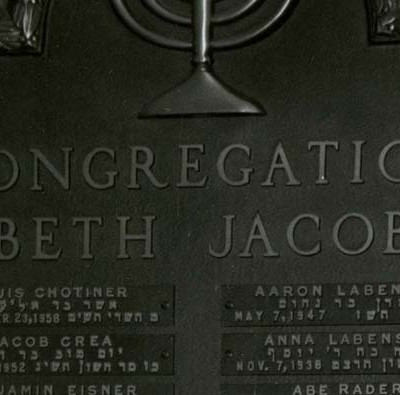
Hopewell Township was created about 1812 from several existing townships in Beaver County. The villages of Aliquippa and Woodlawn became stations on the Pittsburgh & Lake Erie Railway along the Ohio River over the following century. Both grew dramatically after the Jones and Laughlin Steel Company built a mill nearby in 1905.
The first Jewish settler in Hopewell Township appears to be Adolph Itzkovitz, who arrived with his family from Hungary in 1904. In the decade after the Jones and Laughlin mill opened, Aliquippa and Woodlawn attracted other Jewish families, many also originally from Hungary. A group organized Beth Jacob Congregation as early as 1910 and chartered the Orthodox congregation in 1915.
Beth Jacob Congregation met at Guman Hall on Sheffield Avenue until 1918, when it built a white brick and tile synagogue at 325 Main Ave., in an older section of Aliquippa. The congregation purchased a residential building in the 300 block of River Avenue in 1923 for its longtime spiritual leader, Rev. Samuel Klein. That same year, Abe Labensky became president of the congregation and remained so for the remaining life of the congregation.
Around the same time Beth Jacob was formed, a second group of Jews living in nearby Woodlawn formed Agudath Achim. They officially chartered the congregation in 1919. When the borough of Woodlawn was merged into the borough of Aliquippa, Agudath Achim became associated with Aliquippa and Beth Jacob became associated with a new municipality called West Aliquippa. The two congregations remained distinct, although their members joined together for community organizations, such as the B’nai B’rith Lodge 1125, founded in 1929. The B’nai B’rith rented rooms in the second floor of the building on Franklin Avenue. The communities also organized Boy Scout Troop 412.
Among the notable members of the Jewish community of West Aliquippa was Dr. Jesse Steinfield (1927-2014), who served as Surgeon General of the United States from 1969 to 1973, under President Richard Nixon. The National Institute for Occupational Safety and Health and the National Health Service Corps were both started during his tenure.
The close relationship between the communities complicates population estimates. The American Jewish Yearbook lists a combined population of 300 for Aliquippa and Woodlawn in its 1918-1919 edition and a population of 115 for Aliquippa alone in its 1928-1929 edition. Regional historian Jacob Feldman, in his book The Jewish Experience in Western Pennsylvania, A History: 1755-1945, attributes this population figure exclusively to Beth Jacob and associates approximately 300 additional people to Agudath Achim. The American Jewish Yearbook listed a population of 410 for Aliquippa and 75 for Hopewell Township in its 1940-1941 edition, 400 for both communities in its 1951 edition and 400 for Aliquippa in its 1984 edition, after both congregations had closed.
Agudath Achim dissolved in 1959 and the Jewish community in the area chartered a new entity called the Aliquippa Jewish Community Center, which was more closely aligned with the Conservative movement. That same year, Beth Jacob also dissolved and merged into the new community center. Aliquippa Jewish Community Center merged with Beth Samuel Congregation in Ambridge in 1970 to form the Beth Samuel Community Center.